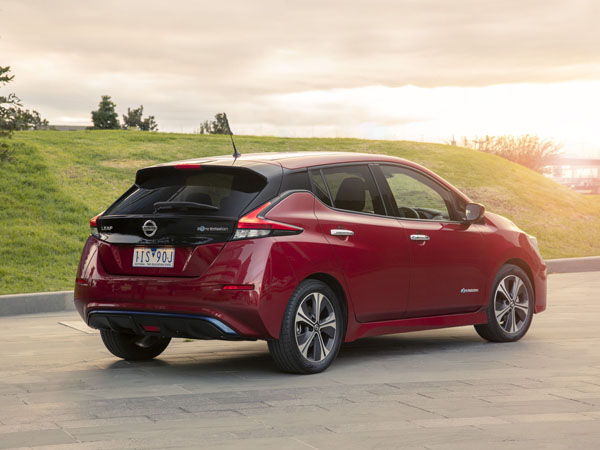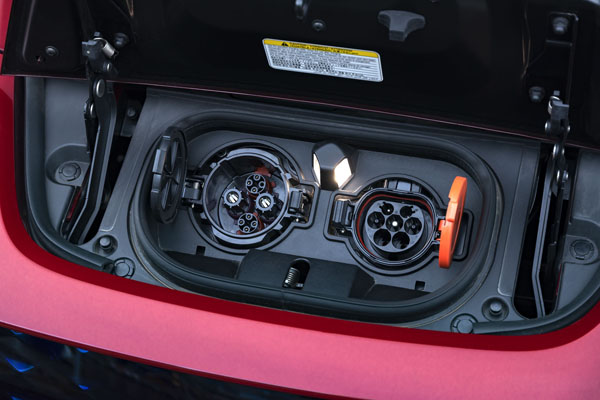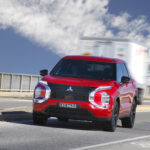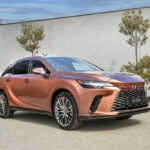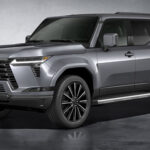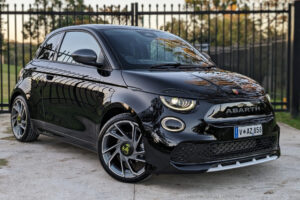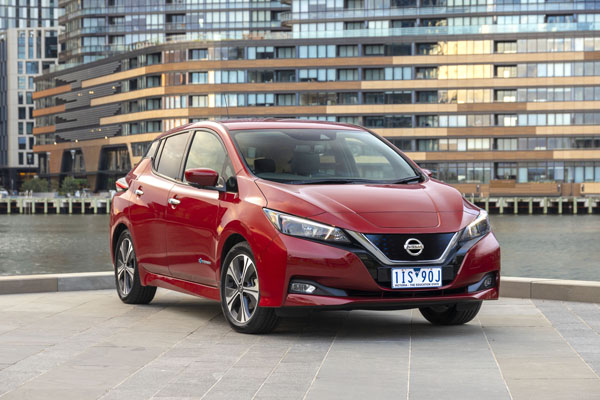 One in ten new vehicles on the road in Australia by 2025 – that’s about 100,000 – will use some sort of electric power. That’s the prediction of Nick Thomas, the Nissan global director of electric vehicles.
One in ten new vehicles on the road in Australia by 2025 – that’s about 100,000 – will use some sort of electric power. That’s the prediction of Nick Thomas, the Nissan global director of electric vehicles.
“As the cost of the traditional internal combustion engine goes up, that of the battery comes down, making EVs an attractive proposition. There is a price crossover point coming,” he said.
The Leaf first saw the light of day in 2010, arriving in Australia two years later. Since then more than 410,000 have been sold in 51 markets, making it one of the most popular electric vehicles in the world.
In those days a 24 kWh lithium-ion battery gave the Leaf a range of 170 km. The new Leaf, with its 40 kWh 350V battery, has added 100 km to the range.
The battery can be charged from a standard household power point in about 24 hours, or from empty warning to 80 per cent in 60 minutes. And the Leaf can return the compliment with the unique capability of returning power from its battery to the grid for home or business use.
This means the car can be charged during off-peak periods, say overnight, and plugged in to the home to power the kettle, cooker or even hairdryer in the morning high-rate period.
Alternatively, the Leaf can be charged ‘on the run’ at any of 783 public stations around Australia, of which 69 are of the quick variety, doing the job in 60 minutes. Queensland government, for example, has installed a string of 18 DC chargers between Coolangatta and Cairns.
At $49,990, plus on road costs, the new Leaf is not cheap. Then there is the option of having a fast charging unit fitted at home. This can add up to more than $1500, depending on the unit.
STYLING
On the outside, new Leaf maintains the look of a conventional hatchback, while proudly carrying EV badging and ‘zero emission’ tag, the latter on both flanks.
Nissan’s aim was clean and simple lines and a sleek silhouette wrapping around its hi-tech workings. Branding is taken care of by the company’s signature V-motion radiator grille, boomerang light set-up and floating roof.
Dusk sensing LED headlights with dual, direct-lens low and high beams, enhancing illumination ahead, are a first for Nissan. Aerodynamic body features and wheels gives the Leaf a drag co-efficient as low as Cd 0.28.
INTERIOR
Inside the cabin the word was premium ambience with room to relax. A sporty flat-bottom, leather wrapped heated steering wheel incorporates multi-functions, including Advanced Drive-Assist, which can be used by the driver without taking hands off the wheel.
A redesigned centre console with cup holders between driver and front passenger seats includes a new storage area at its base ideal for phone or wallet, as well as easily reached power switch, 12V outlet and USB port.
The rear cargo area of 405 litres (seatbacks up), 1176 litres (seatbacks down) has been redesigned to offer better use of space. While the lithium-ion battery now has greater capacity, its dimensions have not changed from the previous model, leaving room for five occupants in comfort.
INFOTAINMENT
The combination of analogue speedo and multi-information display uses a 7-inch advanced Drive Assist display on the left incorporating a power meter as the standard setting, which can easily be changed by the driver.
The centre display screen allows the driver to operate audio and navigation systems and connect to smartphones with ease. An 8-inch colour touchscreen allows Apple CarPlay and Android Auto to be operated.
ENGINES / TRANSMISSIONS
The new e-powertrain produces 110 kW of power, 38 per cent more than the previous model and 320 Nm of instant torque, 14 per cent up on the first-generation unit. The driving range is listed as being up to 270 km.
SAFETY
The new Leaf has a five-star ANCAP rating thanks to advanced safety systems such as predictive forward collision warning, intelligent emergency braking, intelligent lane intervention, around view monitor with moving object detection, intelligent cruise control, rear cross-traffic alert, driver alertness, high beam assist and blind spot warning.
Also on hand are vehicle dynamic control with traction control, front and rear parking sensors, front, front-side and side curtain airbags.
Because EVs are quieter than most cars, the new Leaf also incorporates a system that tells pedestrians the Leaf is there. Below 30 km/h and in reverse, the Leaf lets out that’s up to five decibels lower than the conventional petrol or diesel engine. It stops when the car does.
DRIVING
Normal driving conventions apply to the Leaf. Like other electric cars we have driven it’s possible to use it as a one-pedal car. By taking the foot off the accelerator it comes to a smooth, gradual halt and is held without the use of the brake pedal.
In aggressive braking situations, which Nissan says is 10 per cent of the time, the driver can return to using both feet. Both situations were given a solid workout during the test period. With little practice, both situations were easy to use and stress free.
Unruffled is the perfect description of the Leaf’s performance. To match the improved output of the electric motor and converter, engineers enhanced the car’s chassis to improve stability. Also, the heavy battery is situated at the centre of the body to achieve better balance than with a front-engine vehicle.
Electric power steering has a more linear feel and is more responsive to sharp changes in direction. Noise, vibration and harshness have been moderated with aerodynamic upgrades and structural rigidity, while the electric motor has been made quieter, despite generating more power and torque.
There’s some tyre noise. Why wouldn’t there be with little or no sound from under the bonnet?
Plugging in to the common domestic power point will charge the battery from low to full charge in about 24 hours; a second-level charger will do the same in about seven-and-a-half hours; while the top-level system will charge from the empty warning to 80 per cent in approximately an hour.
Nissan engineers also went to work on the battery charging point at the front of the vehicle, altering the angle of the socket allowing owners of all heights to connect the cable without bending down.
SUMMARY
Premium purchase prices and refueling convenience continue to be major hurdles for electric vehicles. But for those wishing to give it a go, the Nissan Leaf is as good as any petrol-powered close rival.
AT A GLANCE
MODEL LINE-UP
Nissan Leaf EV $49,990
Note: This price does not include dealer or government charges. Contact your local Nissan dealer for drive-away figures.
SPECIFICATIONS
(Nissan Leaf AC synchronous motor, 40 kWh lithium-ion 350V battery, reduction drive 2WD, 5dr hatchback)
Capacity: 40 kWh
Configuration: lithium-ion battery, AC synchronous motor, reduction drive
Maximum Power: 110 kW @ 3283-9795 rpm
Maximum Torque: 320 Nm @ 0-3283 rpm
Fuel type: Electric
Driving range: 270 km
CO2 emissions: 0g / km
DRIVELINE:
Drivetrain: Reduction drive, shift by wire, 2WD
DIMENSIONS, WEIGHT AND CAPACITIES:
Length: 4490 mm
Width: 2030 mm including mirrors
Height: 1540 mm
Wheelbase: 2700 mm
Kerb weight: 1594 kg
BRAKES:
Front: Disc
Rear: Disc
WARRANTY:
Five years / unlimited kilometres




